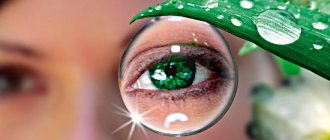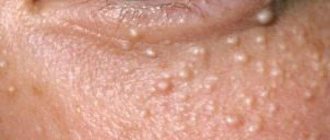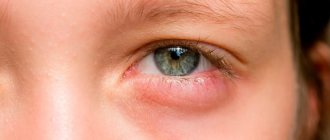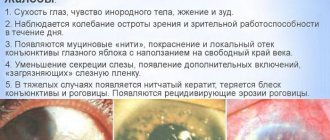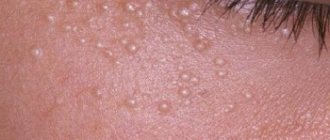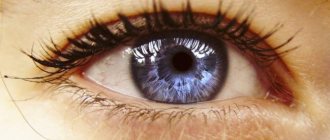Eye diseases are a pressing problem in the modern world. Blepharitis is an inflammation of the tissues of the eyelid and eyelashes. The fourth place in the list of common inflammatory eye ailments is demodicosis blepharitis (tick-borne).
The disease is caused by the microscopic demodex mite, which in turn is divided into two varieties: Demodex folliculorum and Demodex brevis. The former live in the bulbs of the eyelashes, the latter in the sebaceous glands. Hence another name - demodicosis of the eyes and skin of the eyelids. Quite often, both types coexist peacefully on the eyelids of one patient, creating difficulties in treatment due to the intensity of the disease.
ICD-10 code B88.0 Other askariasis
Photo of the cause of the disease - demodex mite under a microscope
Symptoms
A few days after the onset of the first ailments, the patient’s eyelids are affected, and an acute inflammatory process of the ciliary margin begins. Overall, the patient's condition remains relatively good.
Distinctive features include the following phenomena:
- hyperemia, swelling of the eyelids;
- dry eyes, sensation of the presence of a foreign object;
- disruption of the natural moisture of the eye, blockage of the lacrimal glands;
- eyelashes stick together and painful crusts form on them;
- cloudy mucus may appear from the eyes;
- irritation increases with temperature changes, at night, after using cosmetics;
- in severe cases, general weakness of the body appears, body temperature rises to subfebrile levels;
- hypersensitivity reactions are observed in the form of a rash, redness on the body, due to the release of toxins by the parasite during its life.
Symptoms of tick-borne blepharitis can be noticed immediately after the development of the disease, or after a long period of time with a wave-like manifestation, which complicates diagnosis.
It can be confused with other inflammatory and allergic diseases.
What is blepharitis
A group of diseases whose main symptom is inflammation of the extreme part of the eyelids is called blepharitis. This is one of the most common ophthalmological pathologies, as well as conjunctivitis with keratitis.
A pathology develops with certain symptoms, which have a special character depending on a number of factors and, in particular, on the cause of blepharitis. These can be various viruses, bacteria, parasites, etc. To understand the infection process, it is important to know that at the edges of the eyelids there are special duct openings called meibomian glands. If pathogenic microflora, a virus or parasite gets into them, an active process of inflammation begins. Typically, a person’s immune system can cope with a number of blepharitis pathogens and suppress their activity. But in certain cases, the strength of the protective systems is not enough, and blepharitis develops.
The main reasons for the development of inflammatory processes on the eyelids are:
- anemia;
- astigmatism;
- allergic reaction;
- vitamin deficiencies;
- demodicosis;
- myopia and farsightedness;
- a number of autoimmune pathologies;
- barley.
Excessive strain on the visual organs, coupled with chronic fatigue, can also trigger the development of blepharitis. The disease in children often develops due to Staphylococcus aureus getting on the eyelids. Typically, pathogenic microflora begins to actively multiply against the background of heavy physical activity, hypothermia, diabetes, infection with worms, problems with metabolism and other features that signal a weakened immune system of the body of a child or an adult.
Blepharitis is also provoked by an unfavorable environment (for example, smoke in the air, exposure to chemicals, contact with foreign objects in the eyes), as well as failure to comply with personal hygiene rules. Women who use other people's eye cosmetics also often suffer from this disease.
On a note! Blepharitis can act as an independent disease, as well as be a concomitant pathology with a number of other health problems.
Demodectic blepharitis: causes of the disease
Larvae and mature Demodex individuals can exist quietly in the human body, without manifesting themselves in any way, without causing harm to the owner. The parasite lives in the deep layers of the epithelium.
- About 90% of the world's population are carriers of the Demodex mite, most of whom do not experience any discomfort with the presence of the parasite.
- In 70% of cases when eye mites are diagnosed, patients have demodicosis of the face.
Provoking factors that trigger the disease:
- various hormonal fluctuations;
- problems of the gastrointestinal tract, deterioration of the natural intestinal microflora;
- disruptions in the nervous system, prolonged mental and physical overstrain;
- weakened immune system, hypothermia;
- abuse of solarium;
- the use of low-quality cosmetics that violate the natural protection of the eyes;
- long-term recurrent chronic diseases;
- neglect of personal hygiene, including sharing of towels and cosmetics.
As a result of these reasons, the body is unable to resist, the mite becomes more active and begins to infect tissues where the production of sebaceous glands is increased (face, forehead, eyebrows, eyelids). It feeds on dead hair follicle cells.
Symptoms of the disease
Symptoms of the disease may be as follows:
- eyelids become swollen;
- their redness is observed;
- eyelashes begin to fall out;
- the space between the eyelashes is covered with gray scales;
- the corners of the eyes are closed with dry mucous secretions in the morning;
- complex cases are characterized by the formation of ulcers on the surface of the eyelids;
- a person complains of a feeling of a film on the surface of the eye;
- there is a constant pain in the eyes;
- eyelids itch very much;
- gradually the itching spreads to the skin around the eyes.
Some symptoms may be absent, but a characteristic sign of demodectic blepharitis is whitish scales covering the eyelashes. If you observe only some of the above symptoms, then you need to visit an ophthalmologist as soon as possible.
Diagnostics
An example of the development of demodectic blepharitis in the photo.
If such symptoms appear, you should immediately consult an ophthalmologist. The doctor will examine the eyes and take several eyelashes from different affected areas of the eyelids for microscopic examination. The samples are placed on a special glass and treated with glycerin.
Identifying any type of tick allows you to make a correct diagnosis. If necessary, the doctor prescribes additional tests to find out the cause of the disease. This will allow you to remove not only the symptoms, but also select complex therapy.
Symptoms and signs of the disease
Demodicosis of the eye is divided into the following diseases: demodectic blepharitis and blepharoconjunctivitis.
Their symptoms are almost the same.
- Eyes get tired quickly, feeling of heavy eyelids.
- There is an itching and severe burning sensation along the edge of the eyelashes.
- Such diseases cause tingling in the eyes.
- Thick mucus accumulates in the corners of the eyes, sticky to the touch.
- Keratin scales and crusts form on the eyelash bulbs. This causes eyelashes to stick together and fall out.
- Red eyes, dilated capillaries.
- Small pustules form between the eyelashes on the eyelid.
- The mucous membrane of the eye does not work, dryness appears. The sensitivity of the cornea of the eye decreases.
- Barley appears.
- Some components in eye cosmetics contribute to the development of the disease.
- Blepharoconjunctivitis causes photophobia and dryness of the conjunctiva.
Demodicosis is a seasonal disease. When it’s warm outside, in spring and summer, the parasite begins to become active. All symptoms that manifest themselves cannot be ignored; you must consult a doctor.
The characteristic signs of the disease are most noticeable in the morning after waking up. Swollen red eyes with stuck together eyelashes. Often the disease is accompanied by a skin rash.
In the absence of adequate treatment, the disease becomes chronic. Relapses occur from time to time. In general, it causes irritability, depression and neurosis.
Eye mite in the photo
Characteristic symptoms
The patient begins to experience the following symptoms:
- severe itching in the eyelid area;
- burning;
- irritation;
- dryness and peeling of the skin of the eyelids, up to the appearance of bleeding in this area;
- hyperemia and swelling of the eyelids;
- increased visual fatigue.
Symptoms increase when exposed to heat (sun, bath). Later, a specific “sticking” of the edges of the eyelids appears. The eyelashes literally stick to each other, so much so that sometimes it is difficult for the patient to open his eyes. Then they begin to fall out rapidly. A long course of the disease without therapy is fraught with the addition of such diagnoses as conjunctivitis, trichiasis, and keratoconjunctivitis.
The consequences of such a condition can be very dire. In particular, restoring the function of the meibomian glands requires a lot of time and effort.
Treatment
Treatment of demodicosis of the eyelids is based on the severity and extent of the process. Typically, an ENT specialist prescribes drug and non-drug therapy.
Drug therapy
- Antiviral drugs (Metronidazole).
- Antibiotics if inflammation is complicated by a bacterial infection.
- Antiseptics.
- Non-steroidal anti-inflammatory drugs.
- Antihistamine tablets (Erius, Diazolin, Suprastin) in the presence of reactions of allergic origin against the background of general intoxication.
- Drops for dry eyes to produce natural tears.
Eyes with demodectic blepharitis
Non-drug therapy
- Eyelid hygiene must be carried out 2 times a day to cleanse crusts and products of demodex parasitism.
- Massage with Blepharogel and compresses with Blepharolosion are used.
To speed up the healing process, increase the body's defenses, including taking vitamins, immunostimulants, lactobacilli and bifidobacteria to restore intestinal microflora.
Treatment of the disease
Dealing with demodectic blepharitis is not easy, and treatment can take a long time. Therapy will include a whole set of different activities, starting with personal hygiene and ending with the prescription of special acaricidal drops. It is also important to start eating right, drinking vitamins to boost immunity, and doing eyelid massage.
The range of acaricidal drugs offered in pharmacies is very large. But it is better to buy the product that your doctor prescribes. Usually these are preparations based on metronidazole, sulfur, combined with extracts of herbs such as tansy, wormwood, and calendula. Tear substitutes and allergy medications may be prescribed. All anti-blepharitis remedies have a negative effect on mites, but not on their eggs. Therefore, treatment will have to take place in courses, killing adult individuals and then young ones hatched from eggs.
It is very important that the patient uses individual hygiene items throughout the entire treatment period. For example, he should have a separate towel. It is also worth sleeping separately from other family members, using only your own cosmetics, which should be completely replaced with new ones after therapy. In general, during treatment, doctors generally recommend not using cosmetics. The pillowcase on your personal pillow must be changed every day, and after washing it must be ironed with a hot iron.
Important! When treating this type of blepharitis, it is very important to follow all the doctor’s instructions with high accuracy, otherwise there will be no positive results.
It is important to remove all discharge from the eyes, using clean cotton pads and swabs each time. You can moisten them with herbal infusions and special solutions.
Doctors also advise doing warm compresses and self-massage using special lotions. A course of phonophoresis may be recommended. Depending on the patient's condition, antibiotics and NSAIDs are also prescribed.
As for diet, it also helps fight the demodectic form of blepharitis. It is recommended to include greens, vegetables, and fruits in the menu. It is advisable to consume as much vegetable oil as possible, but it is better to exclude fatty and fried oils, as well as sweets and baked goods.
Complications
The photo shows demodectic blepharitis in the eyes of an adult patient.
If the disease is not treated, then serious consequences are possible, such as: impaired eyelash growth, up to their complete loss, severe hyperemia of the eyelids with subsequent spread to other parts of the eye; blurred vision, disruption of the lacrimal glands and their blockage; dry eyes, general poisoning of the body due to the toxic effect of the mite, increased tendency to allergic manifestations.
Types of pathology and symptoms
Common symptoms that occur with almost any form of blepharitis are swelling of the eyelids, itching, redness of the outer part of the eyelids, problems with eyelash growth and their loss. Also, as a result of the disease, the eyelashes themselves stick together due to the secreted mucous and tear masses. The eyes cannot perceive bright light and hurt, and also get tired very quickly under any load, even minimal.
Blepharitis can be divided into several types according to various classifications. So, from an anatomical point of view, two types of pathologies are distinguished:
- anterior, when only the edge of the eyelids with eyelashes is affected;
- posterior, when the disease affects the glands located deep in the eyelid. The cornea and conjunctiva may also become inflamed.
On a note! Doctors note that they are often approached by patients who have both anterior and posterior blepharitis. In this case, the eyelid is completely inflamed.
Also, all blepharitis can be divided into several categories depending on the cause of development. The symptoms of the forms will be slightly different, with the exception of one aspect - the inflammatory process in the tissues of the eyelids.
Types of blepharitis
Demodectic blepharitis
There is another form of blepharitis that is quite widespread - demodectic blepharitis. Its cause is damage to the eyelids by the Demodex mite. This is an opportunistic parasite that can easily live in a person’s skin permanently without causing much discomfort or health problems. However, if the mite population becomes too large, inflammatory processes begin to actively develop.
On a note! Doctors can detect Demodex mites in 90% of people during a detailed examination. But demodectic blepharitis, like demodicosis itself, does not always develop.
The size of the mite is very small - only 0.2-0.5 mm, and these parasites live in the skin, in the ducts of the sebaceous glands, in the meibomian glands, and the mouths of hair follicles. They can live on both animals and humans. The parasites move very slowly; about 25 representatives of the species can live in one follicle and feed on gland secretions and epithelium. They are more active in the dark. Ticks live for about 1-2 months. The parasite itself and its activity can suppress the activity of T-lymphocytes and reduce immunity.
Demodectic blepharitis
Infection occurs through household contact. Parasites also prefer to live in dust and pillows, although outside the human body they can last no more than three days, but this period is sometimes enough for infection and the development of the disease. By the way, it is the waste products of the tick that are most dangerous to humans, and not the parasite itself, since they can provoke serious allergic reactions.
The reasons leading to the active reproduction of ticks include:
- decreased immunity;
- exposure to high temperatures;
- ophthalmological operations;
- problems with the functioning of the endocrine and circulatory systems;
- exposure to sunlight;
- problems with the gastrointestinal tract;
- failure to observe basic personal hygiene;
- use of certain medications (antibacterial, hormonal);
- violation of metabolic processes.
In the chronic course of the disease, conjunctivitis develops over time.
Prevention
To prevent tick-borne blepharitis, you should adhere to the following recommendations:
- keep chronic diseases under control and prevent their exacerbation; be examined at least once a year;
- take vitamins, do not overcool;
- do not abuse the solarium;
- adhere to personal hygiene (do not use someone else’s or low-quality cosmetics, share a towel, do not touch your eyes with dirty hands);
- replace pillows with natural fillings with synthetic analogues
A tick in front of your eyes is an unpleasant life episode, but with proper and comprehensive therapy, you can completely get rid of it. The main thing is to responsibly follow all doctor’s orders and take care of personal hygiene.
LiveJournal
What is and features of demodectic blepharitis
The disease manifests itself as inflammation of the eyelids, caused by the vigorous activity of opportunistic microorganisms of the genus Demodex. Normally, 2 demodectic mites live on 15-16 eyelashes. In the initial stages of development, tick-borne blepharitis has no symptoms. A person turns to an ophthalmologist when the disease becomes chronic; at this stage, therapy can take more than two months.
The patient poses a danger to others. People and animals that come into contact with it can become infected within two to three days.
The opportunistic microorganism is well preserved and multiplies at high humidity in the room, remaining on pillows and bed linen.
Tick-borne blepharitis: traditional methods
Source: gesund.at
There are many popular recipes that allow you to avoid resorting to drug treatment. Treatment of demodicosis with traditional methods sometimes gives results an order of magnitude higher than with therapy with drugs sold in pharmacies. But still, a consultation with a dermatologist is necessary!
Among the traditional methods of treating blepharitis, the most effective is the use of aloe vera. The juice of this plant has amazing healing properties, thanks to which it can be used not only as an external remedy, but also taken internally. Thus, aloe vera is a complex remedy.
To treat blepharitis, we recommend using an infusion of one tablespoon of thyme per glass of boiling water. Leave for an hour, cool, strain and rinse your eyes with this product twice a day.
To prepare this folk remedy for the treatment of demodicosis of the eyes, you will need 2 tablespoons of cordate linden, poured with a glass of boiling water and boiled in a water bath for 10 minutes. The resulting mixture is wiped over the affected areas in the morning and evening until complete recovery.
Every day, wipes soaked in the juice of fresh ripe tomatoes should be applied to the affected eyelids for 15 minutes.
- Soak a gauze pad in half a glass of cabbage juice and apply it to your face for 15-20 minutes. Re-wet the napkin in the juice as it dries. The course of treatment is 20-25 procedures, which should be carried out every other day.
- 1 tablespoon of juniper berries crushed in a coffee grinder for 1 glass of boiling water, leave for 4-6 hours in a sealed container, strain. Use for lotions 1-2 times a day for 15-20 minutes. Pre-wipe the skin with alcohol tincture of calendula or eucalyptus.
- 1 tablespoon of crushed buckthorn bark per glass of boiling water, simmer covered for 2-3 minutes, leave for 3-4 hours, strain. Use as a lotion 1-2 times a day for 15-20 minutes. Pre-wipe the skin with alcohol tincture of calendula and eucalyptus.
- tricolor violet herb 2 parts, calendula flowers 2 parts, St. John's wort herb 2 parts, mint leaf 1 part, plantain leaf 1 part, elecampane root 1 part. Pour 2 tablespoons of the mixture into 0.5 liters of boiling water, leave for 30 minutes in a sealed container, strain, take 1/2 cup 3 times a day before meals for 4-6 weeks.
With its help, you can treat a disease that occurs against the background of allergies or seasonal exacerbations, when other means are less effective.
To prepare the juice, you need to take several lower and middle leaves of a three-year-old plant, wrap it in paper and put it in the freezer. Keep the aloe in the cold for 12 hours, after which it is cleaned and ground in a meat grinder.
Important
Place the resulting puree on a piece of gauze and carefully squeeze the juice into a glass container - a glass or a jar. Take 3 ml per day orally - you can measure it using a syringe or pipette.
The recommended course of treatment for blepharitis in folk medicine is 21 days. If the disease is in a complex form, the dose can be repeated after a 10-day break.
To instill in the eyes, purified fresh aloe juice should be heated in a water bath to room temperature. Place 2 drops in each eye before bedtime. The recommended course is 21 days. You can repeat after the break.
Every day, apply compresses of aloe juice (a house plant in a pot, found in almost every home) on your closed eyelids. Redness and swelling of the eyelid can be removed by infusion of oak bark (one teaspoon per glass of water), bring to a boil and simmer for 5 minutes.
Important
Garlic juice is also useful as an antimicrobial agent. For compresses, use only a clean cloth or bandage, keep it on your eyes for at least half an hour, changing it every 10 minutes with a new, freshly moistened bandage.
If you follow all the recommendations, this recipe guarantees complete relief from demodicosis of the eyelids. The main ingredient is wormwood herb.
Place two tablespoons of crushed wormwood per liter of hot water, place on the stove, after boiling, reduce the heat and let simmer for a few more minutes. Then the broth needs to brew for 2-3 hours.
Take the finished product orally for 6 days in a row (even at night) according to the following schedule:
- Day 1 – 50 ml every hour;
- Day 2 – 50 ml every two hours;
- Days 3,4,5 and 6 – 50 ml every three hours.
The use of wormwood in this form not only destroys ticks, but also regulates intestinal function. If you cannot stand the bitterness of wormwood, add a teaspoon of honey. This remedy must be prepared every day; do not store it immediately for the entire period of treatment.
Washing procedures using infusions of wormwood, chamomile and celandine will also be useful. 1 tsp. each component per liter of boiled, hot water.
There are several more recipes to defeat demodectic blepharitis. Treatment is complemented by rubbing the entire head with an infusion of tansy flowers and instilling a 20% solution of sodium sulfacyl into the eyes.
To relieve itching, use a decoction of chamomile and drops of dexamethasone diluted 1:10 with distilled water.
To prevent recurrence, you can make masks from mashed cranberries and medicinal plants: cornflower petals, parsley and rose hips.
If after 10 days of treatment a positive result is not noticeable, in this case in the morning you need to lubricate the eyelash edge with brilliant green diluted 1:1 with castor oil. You should eat more vegetables and fruits, take a complex of vitamins A, C and E.
Adjuvant therapy for demodectic type blepharitis
In order to increase the efficiency and speed up the treatment process, patients with demodectic blepharitis are often prescribed physiotherapy, consisting of a set of procedures:
- UHF (ultra high frequency therapy);
- electrophoresis;
- UFO (ultraviolet radiation);
- eyelid massage;
- magnetic therapy.
Physiotherapeutic procedures help speed up the treatment of blepharitis in both adults and children.
Demodectic blepharitis is also treated with folk remedies, which should be used as complex therapy. For example, basil has good healing properties.
To prepare the remedy, take fresh leaves of the plant, wash them and dry them thoroughly. Then grind them in any convenient way. The resulting paste should be applied to the affected eyelids for 10-15 minutes every day, and then washed with warm water.
According to patient reviews, treatment of demodectic inflammation of the eyelid margins with basil is very effective. In many cases, the condition improves already on the 3rd day of using the medicinal mixture.
What is anterior blepharitis and how to treat it, read here.
Diagnosis of demodicosis
Diagnosis of demodicosis by a specialist is carried out by performing an ophthalmological examination.
For this, the following patient material is used:
- secretion of the sebaceous glands;
- contents of purulent discharge;
- hair follicle.
When examining a patient, microscopy, biopsy, tape test, and biomicroscopy of the eye are performed. These methods make it possible to detect the presence of subcutaneous mites.
After diagnosing the eyelids, an acarogram is drawn up, which shows the total number of mites in the area.
If 5 or more mites are detected per 1 cm2 of skin, we can conclude that the patient has a pathology.
The ophthalmologist can make the primary diagnosis directly in the office in the presence of the patient. To do this, just take a few eyelashes and place them on a microscope slide. Thanks to this, the specialist has the opportunity to make a primary diagnosis and prescribe preliminary treatment.
Causes
The source of Demodex mite infection is most often domestic animals, especially if the pet spends a lot of time outside and the owners do not consider it necessary to vaccinate it. You can also become infected from an already sick person through personal hygiene products, for example, a towel or other thing that comes into close contact with the skin. Mites infect hair follicles, sebaceous and meibomian glands.
At risk are:
- people suffering from myopia or farsightedness;
- HIV-infected;
- suffering from diabetes.
If demodectic blepharitis is chronic and difficult to treat with medication, it is necessary to exclude cancer of the sebaceous glands and skin cancer. To do this, it is necessary to perform a biopsy of the test material.
Prevention methods
Basically, demodectic blepharitis develops in people who have problems with the immune system. To prevent such a disease, it is necessary to strengthen the defense system by taking appropriate vitamin complexes and giving up bad habits and unhealthy diets .
This will help restore normal activity of the gastrointestinal tract, which also becomes an indirect cause of demodicosis of any type (chronic, meibomian, allergic, scaly, etc.)
After successful treatment of blepharitis, from time to time you can use a prophylactic drug such as blefarogel-2 .
This means for repeated and prophylactic treatment prevents the occurrence of relapses of the disease.
Important! The most important preventive measure is compliance with personal and general hygiene standards.
Even in the absence of signs of blepharitis, members of the same family should use separate towels so that the tick is not transmitted from the carrier to another person through household contact.
Features of treatment in children
The immunity of the youngest patients is not as strong as that of adults. Here, individual therapy is selected based on the patient’s age and the severity of the disease. Treatment is complicated by the inability to use certain drugs.
The basis of therapy is eyelid skin hygiene. To cleanse the skin of scales, it is better to use special baby shampoos. The composition is diluted in accordance with the instructions and used to cleanse the eyes. It is now equally necessary to monitor the cleanliness of the baby’s hands, as well as all objects with which he comes into contact (toys). It is better to change bed linen and towels, and wash dirty linen in hot water and iron.
For therapeutic treatment of the eyes, hydrocortisone ointment (concentration 2.5%) or Dex-gentamicin is usually used. It must be applied to the edges of the eyelids several times a day, without rinsing off. Be sure to apply the composition before bed and leave it overnight. This way you can quickly suppress tick activity and speed up recovery.
When symptoms of conjunctivitis occur, Dexapos is used.
Causes of blepharitis
Inflammation of the eyelids can be caused by various factors. The most common causative agent of blepharitis is Staphylococcus aureus, a genus of dangerous bacteria that causes many diseases in humans in almost all organs and tissues.
Today, its carriers are from 25 to 40% of the world's population. Staphylococcal infection spreads in the mucous membranes of the upper respiratory tract, as well as on the epidermis. When staphylococcus enters the hair follicles of the eyelashes, it provokes the development of blepharitis. Other causes of the disease are bacterial and viral infections, various allergens: cosmetics, household liquids, pollen from flowering herbs or trees, animal hair. However, doctors call the most common type of blepharitis demodicosis. Among all inflammatory pathologies of the eyelids, blepharitis of this etiology occurs in almost half of the cases. Demodicosis is widespread, although its carriers may not have any manifestations of this pathology.
